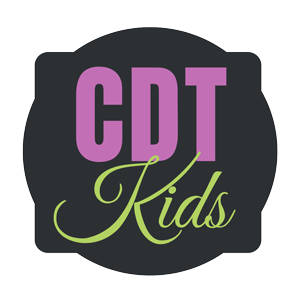Speech & Language Strategies
Many parents understand that children learn through play and that it is important for learning to be fun. At the same time, parents may be concerned about their child's individual needs, and worried that their child is not getting intensive, direct intervention that might be required. When families first visit CDT Kids, a common reaction is:
"This looks like lots of fun, but the children are 'just' playing. When do they get the speech & language therapy?
"This looks like fun, but the children are only playing. When does the real teaching start?"
Individual learning needs can be addressed in the classroom environment through the selection and use of specific intervention strategies. Rarely is there a need to remove a child from the classroom setting for an individual treatment setting. In particular, it is becoming well documented that speech and language skills of young children are best facilitated within a typical classroom environment. The natural, nurturing environment at CDT Kids, with the application of specific strategies, will enhance children's language and communication skills. These strategies are based on the functional need of the child to communicate. This need to communicate gives him/her control over the environment. Such naturalistic needs can be created through arranging the environment to create a need to communicate and then applying an appropriate language facilitation strategy. Appropriateness of the strategy is determined by the context and individual child’s skills. At all times care is taken to provide exciting and fun opportunities for using communication skills while avoiding extensive drill and unnatural conversational requests. Specific intervention strategies that may be selected for facilitation of communication and language skills are detailed below. It is important to note, that often the best intervention includes a combination of strategies and many of the following strategies may naturally occur or co-occur with each other.
1. Modeling
With this strategy, the adult demonstrates the word or words necessary for the child to communicate within the context of typical ongoing activities. For example, if a child attempts to take a toy that another child has, the adult might say "Ask Susan if you can play too." As a further example, if a child is looking at and reaching for a ball that is out of reach, the adult would say "ball" and then hand the child the ball. It is important to note, that with modeling strategies the adult DOES NOT REQUIRE THE CHILD TO IMITATE THE MODELED UTTERANCE. Modeling is one of the simplest and most effective intervention strategies when the model is provided at the exact moment a child is focusing his/her attention on the object or event.
Techniques closely related to modeling are expansion, commenting, and associative strategies. Expansion occurs when the adult adds more information to the words the child is already using (for example, when the child says "car" the adult might expand by saying "yeah, a red car."). Commenting occurs when the adult talks about what the child is doing, while she/he is doing it. Associative strategies pair words with motor activities (as for example, modeling the word "jump" while the teacher and children are jumping up and down). Music activities that associate gross motor actions, music, and lyrics are another example.
2. Sabotage
This encompasses a group of techniques whereby the teacher purposely engineers the environment so as to create a need for the child to communicate or to attempt a new skill. These procedures must appear natural to the child, with no suggestion that the adult is being negative or withholding. Specific strategies are as follows:
- Violation of Routine Events: A familiar and/or necessary step is omitted or performed incorrectly.
- Withholding Objects and Turns: Most activities require the use of several materials, and many require turn taking. Withholding an object or turn (in an apparent oversight) is effective in stimulating children to initiate language to gain attention, request an object, or code intention or state.
- Violation of Object Function or Object Manipulation: When children are familiar with action schemes for specific objects or object roles that compose routine events, the clinician may intentionally violate these routines to stimulate children to initiate directives and make protests.
- Hiding Objects: This is useful in facilitating use of question forms and coding negation.
3. Using Familiar Routines
We have purposefully organized our classrooms around very familiar, predictable routines because we have found this to be a powerful tool for learning. For example, in our circle time routine, the child comes to know exactly what to expect, and can gradually participate at a higher and more complex level. In the beginning she may just listen to the song, then gradually she may start to do some of the hand movements associated with it, and finally she will join in the singing. Similarly for the snack routine, because it is always basically the same, she will learn that hand washing comes first and is a cue that food is coming! The books we use depend on familiar, repeatable lines so that your child gradually comes to fill in the words on his/her own. Pretend play builds on familiar routines (for example, feeding the baby and putting it to bed); young children may be able to just go through the motions at first, but will gradually start to use words and more complex language to tell the baby it's bedtime.
4. Scaffolding
This is a strategy in which the teacher provides a bridge between what the child can and cannot do by providing the necessary prompts or cues. Through the use of modeling and prompting at a level slightly higher than the child's, the adult enables the child to perform more independently at higher levels. For example, when reading "The Three Little Pigs" to the child, the adult might prompt the child with questions such as "Uh-oh, it's the wolf again. What do you think he's going to do?" For scaffolding to be effective, the teacher must be aware of the child's abilities in order to provide appropriate prompts and cues. Scaffolding can also be used to facilitate self-help skills such as placing a cup on the table after drinking. By providing a visual cue such as the lid of a small container secured to the table, the child is directed to place the cup on the lid as opposed to dropping or throwing the cup on the table.
5. Redirection
This is a technique that can be used to encourage child-to-child interaction and also provide children with appropriate language skills for initiating and maintaining social interaction. Many children will often approach the classroom teacher in an attempt to get their needs met. A redirect of such initiations by the clinician would include encouragement to enlist the assistance of a peer, e.g., "Why don't you get Ellie to help you?" or "Why don't you see if Ellie wants to do it." Redirections can vary in the amount of speech & language information or modeling that is provided, ranging from the more general redirect in the preceding example to a vocabulary-based or exact model prompt. A vocabulary prompt would be a redirection that provides a child with the appropriate vocabulary but not an exact model for production, e.g., "Why don't you get Ellie to help you get the paint?". An exact model prompt would be a redirection that provides a child with the precise language information needed, e.g., "Tell Ellie, I need help with the paint."





